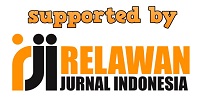SERANGGA HERBIVORA YANG BERASOSIASI PADA TANAMAN JAGUNG DENGAN JENIS PUPUK BERBEDA
Abstract
This research aims to determine the indirect influence of fertilizers on the population and diversity of herbivorous insects in sweet corn varieties super sweet. The research was conducted from the month from May to September 2011 in the Pakel , Gelam village, Kelurahan Cipocok Jaya, Kota Serang. Experiments used designed randomized block design (RBD). The data were analyzed by Anova and DMRT 5%. The herbivour diversity analized by Shannon diversity index. Experimental variable is the type of fertilizer, compost siam weed at a dose of 45 tons / ha, with a dose of manure 45 t / ha, and synthetic fertilizer consisting of urea at a dose of 400 kg / ha, SP36 and KCl dose of 150kg/ha dose 150kg / ha and the control of maize without fertilizer. The fourth variable is repeated 6 times. Observations were made every 2 weeks for orders, families and populations of plant-feeding insects (herbivores) by directly counting the insects which at that time was on the plant. The results showed that the type of fertilizer is not directly influenced by the high population of herbivorous insects. Plants are fertilized siam weed compost herbivore species diversity is high, but their population is foreign-low type. While NPK fertilized plants herbivoranya low diversity and population of each type of the highest good in sucking and biting insects pencucuk chewers. Associated herbivorous insects on corn consists of groups biter chewers like grasshoppers (Acrididae) and pencucuk like ticks sucking aphids (Aphididae).
Keywords: fertilizer, herbivores, compost, corn, Acrididae, Aphididae
Keywords
Full Text:
PDFReferences
Altieri, M.A. 1999. The Ecological Role of Biodiversity in Agroecosystem. Agiculture Ecosystem and Environment 74: 19-31
Amir, A.M., M. Machfud., dan Soebandrijo. 1997. Pengaruh dosis pupuk nitrogen terhadap perkembangan ulat grayak (Spodoptera litura F.) pada kapas. Prosiding Kongres Perhimpunan Entomologi Indonesia V dan Symposium Entomologi. Universitas Padjadjaran. Bandung, 24-26 Juni 1997
Awmack, C. S dan S. R. Leather. 2002. Host plant quality and facundity in herbivorous insects. Annual Review of Entomology. 47:817-844.
Barker, A. V dan D. J. Pilbeam. 2007. Handbook of Plant Nutrition. Taylor and Francis Group. New York. USA. 605p
Borror, D. J., C. A. Triplehorn, dan N. F. Johnson. 1992. Pengenalan Pelajaran Serangga. Edisi Keenam. Penerjemah : Soetiyono Partosoedjono. Penyunting : M. D. Brotowidjoyo. Gadjah Mada University Press. Yogyakarta. 1083 hal
Borowicz, V. A., U. Albrecht, dan R. T. Mayer. 2003. Effects of Nutrient Supply on Citrus Resistance to Root Herbivory by Diaprepes abbreviatus L. (Coleoptera:Curculionidae). J. Environmental Entomology. 32:1242-1249
Giertych, M. J., M. Bakowski, P. Karolewski, R. Zatkowiak, dan J. Gizebyta. 2005. Influence of mineral fertilization on food quality of oak leaves and utility efficiency of food components by the gypsy moth. Entomologia Experimentalis et Applicata. 117: 59-69.
Henn, M. W dan R. Schopf. 2001. Response of Beech (Fagus sylvatica) to Elevated CO2 and N: Infuence on Larval Performance of The Gypsy Moth Lymantria dispar (Lep., Lymantriidae). J. Appl. Ent. 125:501-505
Kagata, H. , M. Nakamura, dan T. Ohgushi. 2005. Bottom-Up Cascade in a Tri-Trophic System: Different Impacts of Host-Plant Regeneration on Performance of a Willow Leaf Beetle and its Natural Enemy. Ecological Entomology. 30: 58–62
Kan, E dan M. Sasakawa. 1986. Assessment of The Maple Aphid Colony by The Hover Fly Episyrphus balteatus de Geer (Diptera:Syrphidae). J. Ethol 4:121-127
Kalshoven, L. G. E. 1981. Pest of Crops in Indonesia (Edisi Terjemahan dan revisi) P. A. Van der Laan. PT Ichtiar Baru-Van Hoeve. Jakarta.
Ludwid, JA & JF Reynolds. 1988. Statistical Ecology: A Primer on Methods and Computing. Jhon Willey & Sons, Nnew York.p 524.
Myers, S. W., and C. Gratton. 2006. Influence of Potassium Fertility on Soybean Aphid, Aphis glycines Matsumura (Hemiptera : Aphididae), Population Dynamics at a Field and Regional Scale. J. Environmental Entomology 35:219-227
Panda, N and G. S. Khush. 1995. Host Plant Resistance to Insects. Cab International. Manila. 431p
Prudic, K. L., J. C. Oliver, and M. D. Bowers. 2005. Soil Nutrient Effects on Oviposition Preference, Larval Performance, and Chemical Defense of a Specialist Insect Herbivore. Oecologia 143:578-587
Rahmawati, A. 2004. Respon Pemberian Chromolaena odorata (L.) King dan Robinson dengan Pemulsaan dan Pembenaman terhadap produksi dan Pertumbuhan Legum (Desmodium rensonii). Skripsi Faperta IPB (tidak dipublikasikan).
Reyes, P. C., M. Quesada, P. Hanson, and K. Oyama. 2007. Interactions Among Three Trophic Levels and Diversity of Parasitoids : A Case of Top-Down Processes in Mexican Tropical Dry Forest. J. Environmental Entomology 36(4):792-780
Santiago, R; R.A. Malvas; M.D Bachmonde; P. Reville & X.C Santo. 2005. Free Phenol in Maize Pith and their Relationship with resistance to Sesamia nonagrioides (Lepidoptera: Noctuidae) attack. Economic entomology. Vol. 98 no.4 hal: 1349-1356
Subandi, I.G Ismail, Hermanto 1998. Jagung. Teknologi produksi dan Pascapanen. Puslittan.
Untung 1993. Pengantar Pengelolaan Hama Terpadu. UGM Press. Yogyakarta
Widstorm, N.W & M.E Snook. 2001. Recurrent Selection for Meysin, a Compound of Maize Silks, Antibiotic to Earworm. Plant Breeding. Vol 120. Hal: 357-359
Wiesenborn, W. D. 2005. Biomass of Arthropods Trophic Level on Tamarix ramosissima (Tamaricaceae) Branches. J. Environmental Entomology 34:656-667.
Yan, F; C. Xu; S. Li; C.Li & Y. Li. 1995. Efek of DIMBOA on Several Enzimatic System in Asian Corn Borer. Journal of Chemical Ecologi. Vol 21. No. 12
DOI: http://dx.doi.org/10.33512/j.agrtek.v4i1.615
Refbacks
- There are currently no refbacks.
Copyright (c) 2016 Jurnal Agroekoteknologi
INDEXED BY:
View My Stats

This work is licensed under a Creative Commons Attribution 4.0 International License.










